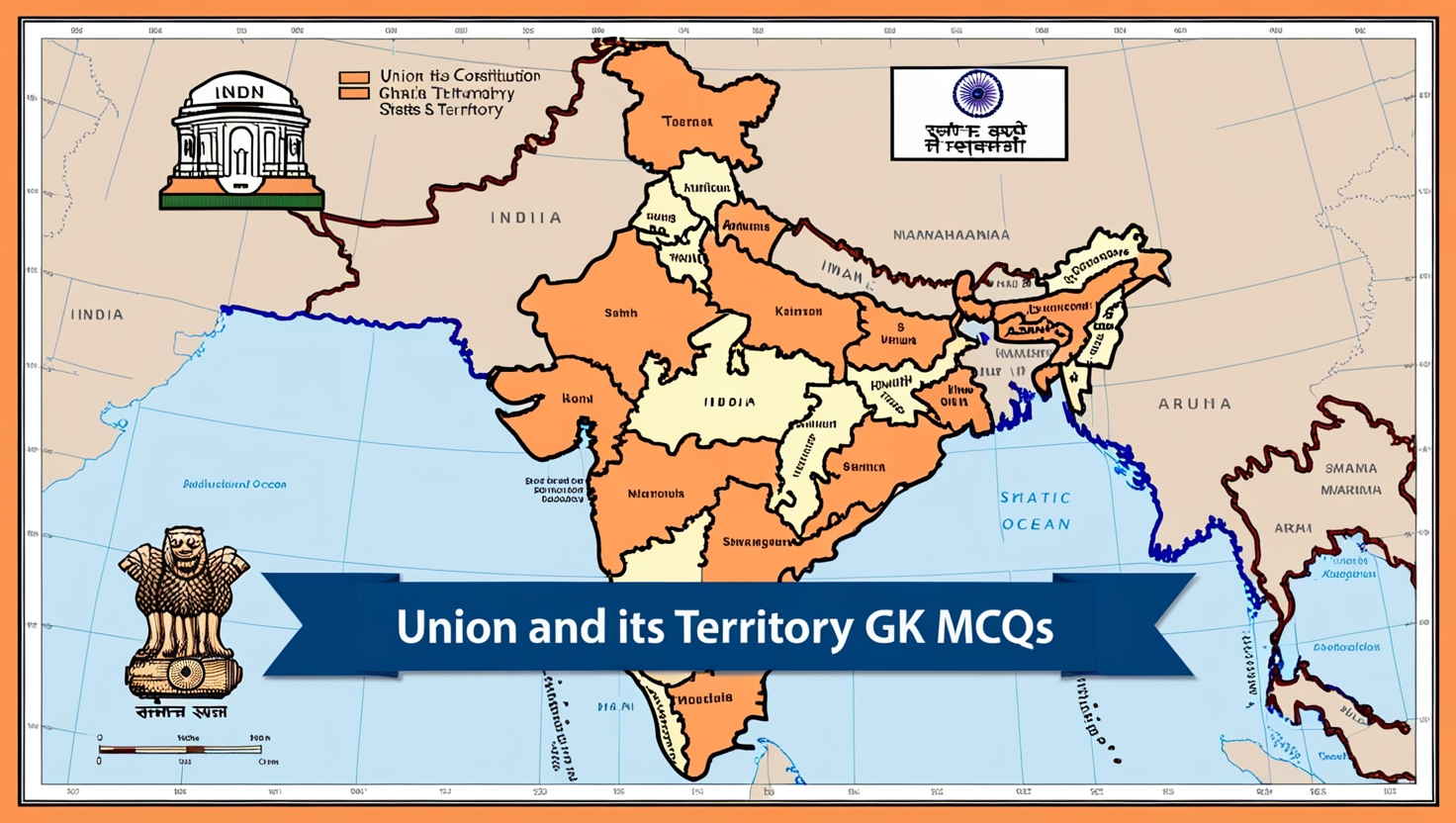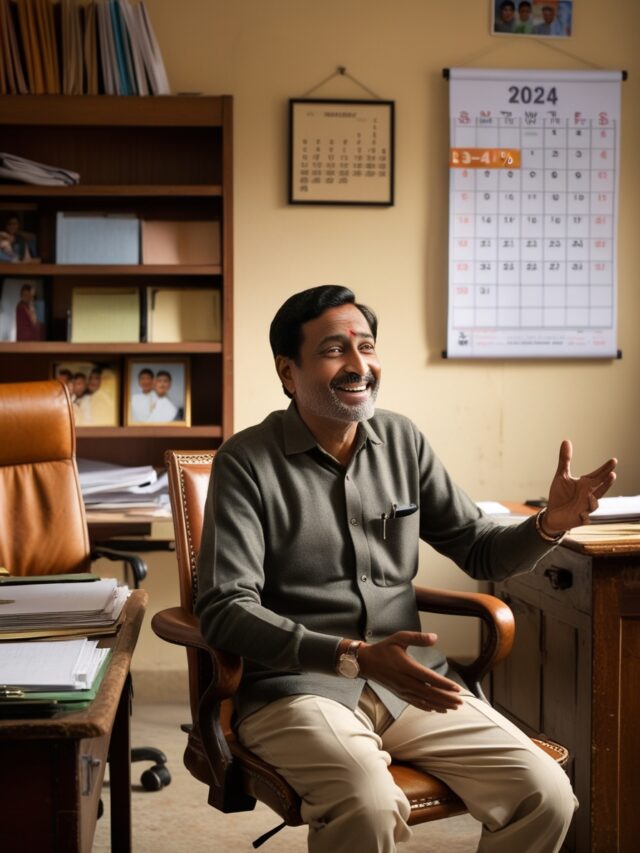
1. The makers of the Constitution of India chose the scheme of federation of India, as prevalent in which among the following countries?
- United States
- United Kingdom
- Australia
- Canada
Show Answer
Answer: United Kingdom
The Constitution of India’s makers adopted a federal structure for the country, similar to the model in the United Kingdom. As a result, the Indian parliamentary system draws substantial inspiration from the British parliamentary system, which is characterized by a parliamentary form of government.
2. The ultimate sovereignty in the Indian Polity rests with which among the following?
- Parliament
- Council of Ministers
- Higher Judiciary
- People of India
Show Answer
Answer: People of India
In contrast to the British system, which is built on the doctrine of the sovereignty of Parliament, the Indian Parliament does not possess supreme authority. Its powers are limited and restricted due to several factors, including a written Constitution, a federal system, judicial review, and fundamental rights. The phrase “We The People of India” in the Preamble signifies that ultimate sovereignty resides with the people of India, not the Parliament.
3. By which Constitutional amendment, Sikkim became a new state in the Indian Union?
- 32nd, 1974
- 35th, 1975
- 36th, 1975
- 37th, 1978
Show Answer
Answer: 36th, 1975
Sikkim became a state of India through the Thirty-sixth Amendment Act of 1975, officially joining the Indian Union on April 26, 1975. The Sikkim State Day is observed on May 16 each year to commemorate the day when the first Chief Minister of Sikkim assumed office.
4. What is the correct chronological order of the creation of Assam, Nagaland, Goa & Mizoram?
- Assam, Nagaland, Goa, Mizoram
- Assam, Mizoram, Nagaland, Goa
- Assam, Nagaland, Mizoram, Goa
- Assam, Goa, Mizoram, Nagaland
Show Answer
Answer: Assam, Nagaland, Mizoram, Goa
The chronological order of the formation of states in India is as follows: Assam was formed in 1950, Nagaland in 1963, Mizoram on February 20, 1987, and Goa as a state on May 30, 1987.
5. Which among the following state/union territory got birth with the Punjab Reorganization Act of 1966?
- Haryana
- Himachal Pradesh
- Chandigarh
- None of the above
Show Answer
Answer: Haryana
The state of Punjab was bifurcated to create Haryana in 1966, marking the seventeenth state of the Indian Union. The Union Territory of Chandigarh was also established from the same territory.
6. Which among the following constitutions is similar to the Indian Constitution because of a strong center?
- USA
- Canada
- England
- Japan
Show Answer
Answer: Canada
The concept of a strong center in the Indian federal system is borrowed from Canada. The term “Union of States” is also influenced by the Canadian federal structure.
7. In which year did Manipur and Tripura become full-fledged states of India?
- 1962
- 1968
- 1972
- 1980
Show Answer
Answer: 1972
Tripura, Manipur, and Meghalaya attained full-fledged statehood on January 21, 1972, under the North Eastern Region (Re-organization) Act of 1971.
8. Which among the following formed as the 22nd state of the Indian union?
- Goa
- Arunachal Pradesh
- Sikkim
- Telangana
Show Answer
Answer: Sikkim
Sikkim emerged as India’s 22nd state on 26th April 1975. The Sikkim State day is observed on 16th May every year because this was the day when the first Chief Minister of Sikkim assumed office.
9. What was the number of states in India after the States Reorganisation Act 1956, which reorganised the boundaries of different states on a linguistic basis?
- 13
- 14
- 15
- 20
Show Answer
Answer: 14
The States Reorganisation Act of 1956 was a significant reform that redefined the boundaries of India’s states and territories, aligning them along linguistic lines. Although there have been subsequent changes in state boundaries, the 1956 Act remains the most extensive change in state boundaries since India’s independence in 1947.
10. In which schedule of the Indian Constitution, the territorial extent of Indian states and union territories is prescribed?
- 1st
- 2nd
- 3rd
- 4th
Show Answer
Answer: 1st
The First Schedule of the Indian Constitution lists the states and territories of India, including any changes to their borders and the laws responsible for those changes.
Q11: At the time of commencement of the Indian constitution, all states of the Union of India were put into four parts A, B, C, D, later reorganised and reduced to 2 categories ‘states and union territories’ in 1956. Which of the following was the only one member of D?
1. Vindhya Pradesh
2. Bombay
3. Madras
4. Andaman & Nicobar Islands
Show Answer
Answer: 4
Explanation: The original Constitution of 1950 categorized states and territories into three main types: Part A states, Part B states, Part C states, and Part D territories. The Andaman and Nicobar Islands were the sole Part D territory, administered by a lieutenant governor appointed by the central government. These classifications have evolved over time as new states and Union Territories have been created or reorganized.
Q12: Arrange Himachal Pradesh, Manipur, Kerala, Maharashtra in the correct chronological order of creation?
1. Maharashtra, Kerala, Himachal Pradesh, Manipur
2. Kerala, Maharashtra, Manipur, Himachal Pradesh
3. Kerala, Maharashtra, Himachal Pradesh, Manipur
4. Maharashtra, Himachal Pradesh, Manipur, Kerala
Show Answer
Answer: 3
Explanation: The chronological order of the creation of states in India is as follows: Kerala in 1956, Maharashtra in 1960, Himachal Pradesh in 1970, and Manipur in 1971. These were important developments in the reorganization of states in India following independence
Q13: In which year was Andhra Pradesh created?
1. 1950
2. 1952
3. 1956
4. 1960
Show Answer
Answer: 3
Explanation: The Congress in its Jaipur session appointed a three-member committee, popularly known as the JVP committee after the name of its leaders – Jawaharlal Nehru, Vallabhbhai Patel, and Pattabhai Sitaramayya. The committee rejected language as the basis of the reorganization of states. Potti Sreeramulu, one of the activists demanding the formation of a Telugu-majority state, died on 16 December 1952 after undertaking a fast-unto-death. This resulted in the creation of the first state on a linguistic basis for Telugu-speaking people called Andhra State on October 1, 1953. It was later reorganized as Andhra Pradesh in 1956.
Q14: In which year was Uttaranchal renamed as Uttarakhand?
1. 2004
2. 2005
3. 2006
4. 2007
Show Answer
Answer: 4
Explanation: Uttaranchal, the 27th state of India, was carved out of Uttar Pradesh on November 9, 2000. Its name was changed to Uttarakhand in January 2007.
Q15: JVP committee, which was constituted in 1948-49, was related to which of the following?
1. Industrialization of India
2. Formation of new states on a linguistic basis
3. National language of India
4. Reservation for SC & STs
Show Answer
Answer: 2
Explanation: The JVP committee, named after its leaders Jawaharlal Nehru, Vallabhbhai Patel, and Pattabhai Sitaramayya, was formed during the Congress Jaipur session to examine the recommendations of the Linguistic Provinces Commission (Dar Commission). While the committee’s report in 1949 suggested that it was not an opportune time for the formation of new provinces, it acknowledged the strong public sentiment in favor of linguistic states in the country. This sentiment eventually led to the linguistic reorganization of states.
Q16: Which among the following was not a Union Territory before it was accorded the status of a Full-Fledged state?
1. Himachal Pradesh
2. Manipur
3. Tripura
4. Sikkim
Show Answer
Answer: 4
Explanation: Himachal Pradesh, Manipur, and Tripura were Union Territories before they were upgraded to full-fledged states. Sikkim was admitted to India as a full-fledged state only.
Q17: Which of the following acts later led to the creation of Zonal councils?
1. Government of India Act 1935
2. Indian Independence Act 1947
3. People’s Representation Act 1950
4. States Reorganization Act 1956
Show Answer
Answer: 4
Explanation: Zonal Councils were established via Part III of the States Reorganization Act of 1956; they are statutory bodies.
Q18: In which year was Sikkim included in the North Eastern Council?
1. 1992
2. 1999
3. 2002
4. 2005
Show Answer
Answer: 3
Explanation: The North Eastern Council was set up in 1971 to deal with the problems of seven north-east states of India. It was set up under the legislation called the North Eastern Council Act, 1972. The State of Sikkim has also been included in the North Eastern Council vide North Eastern Council (Amendment) Act, 2002, notified on 23rd December 2002.
Q19: Who among the following functions as Chairman of Zonal Council?
1. Prime Minister
2. Union Home Minister
3. State Chief Minister elected by all chief ministers of respective states
4. President
Show Answer
Answer: 2
Explanation: The Union Home Minister works as the Chairman of the Zonal Councils.
Q20: Which among the following terms correctly represents the Zonal Councils?
1. Advisory Bodies
2. Actually Working Bodies
3. Law Making authorities
4. Administrative Bodies
Show Answer
Answer: 1
Explanation: Zonal Councils are statutory and advisory bodies.
Q21: Who called the Indian people as a single people living under a single imperium derived from a single source?
1. Jawaharlal Nehru
2. Vallabhbhai Patel
3. Dr. B R Ambedkar
4. Mahatma Gandhi
Show Answer
Answer: 3
Explanation: Dr. Ambedkar had said the following words regarding India being a Union of the states: The use of the word Union is deliberate. The Drafting Committee wanted to make it clear that though India was to be a federation, the federation was not a result of an agreement by the States to join in the federation, and that the federation not being the result of an agreement, no state has a right to secede from it. Though the country and the people may be divided into different states for the convenience of administration, the whole country is one integral whole, its people a single people living under a single imperium derived from a single source.
Q22: What will follow if a bill to bifurcate a state is rejected by the state assembly?
1. The Parliament may still proceed with the bifurcation of the state
2. The bill will get lapsed
3. The Governor of the state may initiate reintroduction of the bill
4. The Governor may take the ordinance route to bifurcate the state
Show Answer
Answer: 1
Explanation: Whether the state says yes or no, once the time given to it has passed, the President may recommend the bill to be introduced in any house of parliament. It’s parliament’s prerogative to go ahead.
1. Admit new territories as a new state of India
2. Split or merge existing Indian states
3. Alter the names and boundaries of existing Indian States
4. All of the above
Show Answer
Answer: 4
Explanation: Article 2 of the Indian Constitution empowers the Parliament to create a new state with a simple majority, and no special procedure akin to a constitutional amendment is required for this purpose. Article 3 grants Parliament the authority to alter state boundaries, names, or areas.
Q24: Who said that – India is an indestructible Union of destructible states?
1. Jawaharlal Nehru
2. BR Ambedkar
3. BN Rau
4. Dr. Rajendra Prasad
Show Answer
Q24: Who said that – India is an indestructible Union of destructible states?
1. Jawaharlal Nehru
2. BR Ambedkar
3. BN Rau
4. Dr. Rajendra Prasad
Q25: Currently, how many Union Territories are there in India?
1. 7
2. 8
3. 9
4. 10
Show Answer
Answer: 2
Explanation: As of my last knowledge update in September 2021, there were 8 Union Territories in India. Please verify the current number, as changes can occur over time due to administrative decisions and legislative changes.
Q26: Creation of a new state or change in the name of the state needs an amendment in which of the following schedules?
1. First
2. Second
3. Third
4. Fourth
Show Answer
Answer: 1
Explanation: Creation of a new state or change in the name of a state needs an amendment in the First Schedule of the Indian Constitution.
Q27: Which Schedules contain the provisions regarding the administration of Scheduled areas and Tribal areas?
1. 4th and 5th Schedules
2. 5th and 6th Schedules
3. 6th and 7th Schedules
4. 5th and 7th Schedules
Show Answer
Answer: 2
Explanation: The provisions regarding the administration of Scheduled Areas and Tribal Areas can be found in the Fifth Schedule of the Indian Constitution.
Q28: Whose prior permission is needed to introduce a bill in the Parliament for the reorganisation of States?
1. Chief Minister of the concerned State
2. Governor of the concerned State
3. President of India
4. Rajya Sabha
Show Answer
Answer: 3
Explanation: Prior permission to introduce a bill in Parliament for the reorganization of states is needed from the President of India.
Q29: The bills related to territorial rearrangement of Indian States and Union Territories under articles 2 & 3 need which of the following kinds of majority in Parliament?
1. Simple Majority
2. Effective Majority
3. Absolute Majority
4. Special Majority
Show Answer
Answer: 1
Explanation: Bills related to the territorial rearrangement of Indian states and Union Territories under Articles 2 and 3 of the Constitution require a simple majority in Parliament.
Q30: India had transferred the Berubari territory to which of the following countries?
1. Pakistan
2. Nepal
3. China
4. Sri Lanka
Show Answer
Answer: 1
Explanation: India transferred the Berubari territory to Bangladesh (formerly East Pakistan) in 1958.
Q31: Which committee recommended the reorganization of States on the basis of administrative convenience?
1. JVP Committee
2. SK Dhar Commission
3. Fazl Ali Commission
4. Sarkaria Commission
Show Answer
Answer: 3
Explanation: The States Reorganization Commission, formed in 1953, recommended the reorganization of states on the basis of administrative convenience.
Q32: In which year was the first linguistic State formed?
1. 1952
2. 1953
3. 1954
4. 1956
Show Answer
Answer: 2
Explanation: The first linguistic state in India, Andhra Pradesh, was formed on October 1, 1953.
Q33: How many states and Union Territories were created after the recommendations of the States Reorganization Commission formed in 1953?
1. 16 States and 3 Uts
2. 14 States and 6 Uts
3. 15 States and 5 Uts
4. 14 States and 5 Uts
Show Answer
Answer: 2
Explanation: After the recommendations of the States Reorganization Commission, 14 states and 6 Union Territories were created.
Q34: Which of the following was not a member of the Fazl Ali Commission formed in December 1953?
1. Vallabhbhai Patel
2. Fazl Ali
3. KM Panikar
4. HN Kunzru
Show Answer
Answer: 1
Explanation: B. R. Rajam, the then Chief Justice of the Hyderabad High Court, was not a member of the Fazl Ali Commission.
Q35: Which of the following Commissions accepted language as the basis of reorganization of States?
1. Punchhi Commission
2. JVP Committee
3. Fazl Ali Commission
4. SK Dhar Commission
Show Answer
Answer: 3
Explanation: The States Reorganization Commission, headed by Fazl Ali, accepted language as the basis of reorganization of states.
Q36: In which year was Goa conferred statehood?
1. 1967
2. 1987
3. 1995
4. 1992
Show Answer
Answer: 2
Explanation: Goa was conferred statehood in 1987.Q37: Who described India as a quasi-federal state?
Q37: Who described India as a quasi-federal state?
1. Lord Bryce
2. K.C. Wheare
3. Harold Laski
4. G. Austin
Show Answer
Answer: 2
Explanation: Granville Austin, a noted constitutional historian, described India as a quasi-federal state in his analysis of the Indian Constitution.







